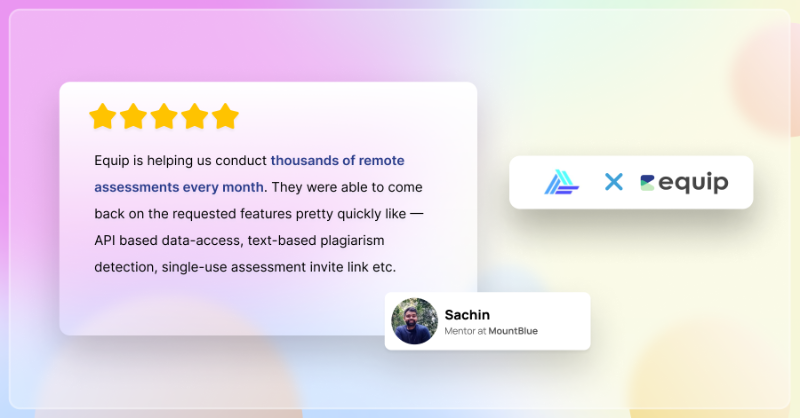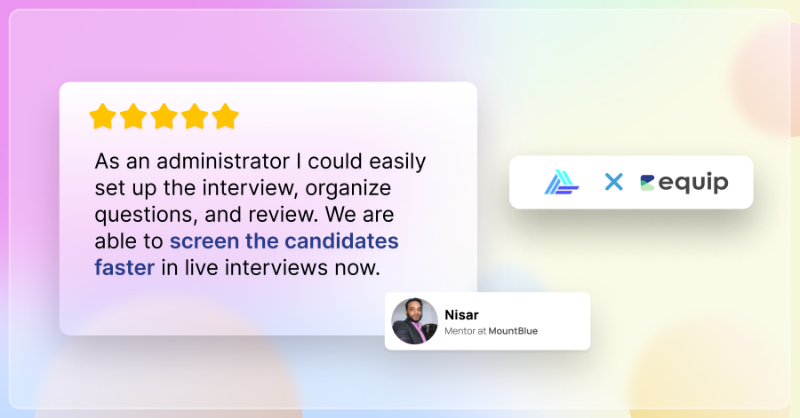This article delves into why coding bootcamp MountBlue Technologies chose Equip over HackerRank to identify top developers faster
With over 500,000 students graduating in software development every year, India expects to have the largest population of software developers by 2024. But how many of these developers possess job-ready skills? Research suggests that the aggregate quality of software developers has not changed over the years. To bridge this divide, MountBlue Technologies provides rigorous coaching to freshers to make them technically competent for software development jobs.
MountBlue’s mission is to elevate the careers of entry-level software developers. They provide training for 3 months in a Full Stack Development bootcamp. The developers are then ready to work as software engineers in one of the 185+ companies MountBlue partners with. To date, thousands of developers have upskilled under this model.
Company Size: 201–500 employees
Industry: IT Services and IT Consulting
Headquarters: Bengaluru, IndiaFounded: 2017
Challenge: Vetting several developers for the bootcamp
MountBlue is well known amongst budding developers and provides a great opportunity for them to upskill and work with companies such as Slice, Razorpay, Nykaa and upGrad. It receives many applications and ends up admitting only a tiny fraction of them. So, one of its biggest challenges is to be able to thoroughly screen developers for their existing skills even before they are admitted into the bootcamp.
MountBlue decided to use pre-screening assessments to automate the shortlisting, making the process more objective and less time-consuming. They would create programming tests and share it with all their applicants and then interview only those who performed well on the assessment.
Initially, MountBlue used HackerRank to conduct these programming tests. While HackerRank provides a huge Question Library, MountBlue’s team found it difficult to prevent candidates from cheating. So, a lot of the candidates that qualified for the interviews weren’t as good as they had hoped for.
With limited proctoring capabilities on HackerRank, candidates were then instructed to record their screens using Loom during the test. MountBlue’s Team assessed submissions by individually reviewing these Loom videos. This was cumbersome for the team as well as the candidates. Besides, this method was not foolproof. With a drop in efficiency and raking huge bills for conducting these tests, the company was on the lookout for a platform with robust proctoring, customisable features and an affordable pricing structure to conduct assessments at scale.
Solution: Equip’s five part custom features strategy
Equip’s assessments are proctored by AutoProctor wherein the candidates’ screen, camera and microphone are tracked. Additionally, copy-pasting is disabled on tests to prevent candidates from Googling answers. If they do try to switch tabs or applications, a screenshot is captured as evidence in the proctoring summary. AutoProctor then calculates a Trust Score for each candidates based on any attempts to cheat made by the test taker.
To supplement these existing features, the tech team at Equip developed the following capabilities on the platform:
- Unique URLs for each candidate: A one-time URL can be used only once. If a user clicks on it and logs in to Equip, only the same account can access that URL. If a user with a different account tries to access the same URL, Equip will say that the link has expired. Due to this, candidates could not share URLs with one another, reducing the chances of cheating.
- Answer Any: Different candidates knew different programming languages and the quizzes, similar to the coding tests, should allow the candidate to choose the language they were familiar with. The Answer Any feature enabled candidates to answer questions within a quiz by selecting a programming language of their choice.
- Question Pool: The questions in a Question Pool are almost indistinguishable from one another. So, different candidates co-ordinating on a test is futile. This was perfect to randomly pick questions with similar concepts from a group of questions with an identical difficulty level. See how Question Pool works.
- Randomized Template: Online questions leak to other users very easily. With the Randomized Template feature, MountBlue could upload a question template and different users would see different variants of the question. For instance, if the question is ‘What is x+y?’, the platform would show different values of x and y to each candidate attempting the question. So, Equip was automatically generating multiple variants of the same question so that different candidates would see different questions. This helped reduce candidates’ coordinated efforts of sharing questions.
- Plagiarism Checker: If a candidate were to submit plagiarised code in a programming test, they were automatically flagged on the results dashboard.

Impact: Better Screening, Scalable Assessments
MountBlue piloted these features with a few hundred candidates on its first assessment. When they saw the accuracy of their results improve, they confidently scaled to it up 2000 concurrent candidates for their assessments. Now, the team could set up fortnightly assessments on Equip with ease and screen candidates faster.

They were now able to admit 1 in 3 shortlisted candidates, doubling their success rate as compared to HackerRank. The main benefits they saw with Equip were: (i) better anti-cheating features, (ii) a quicker turnaround time for customization and (iii) a much lower cost as compared to HackerRank. The MountBlue team hopes to continue using Equip to identify candidates with basic programming knowledge so that they can get them industry-ready.
Continue reading: How One Point One Solutions fast-tracked Tech Hiring with Skill Tests
